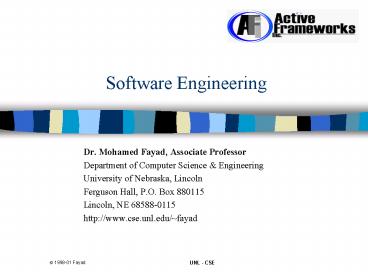Software Engineering - PowerPoint PPT Presentation
1 / 24
Title:
Software Engineering
Description:
The development of tools, methods, and theories to support ... Computer-Aided Software Engineering. 1998-01 Fayad. UNL CSE M.E. Fayad. L1-S20 Introduction ... – PowerPoint PPT presentation
Number of Views:1839
Avg rating:3.0/5.0
Title: Software Engineering
1
Software Engineering
- Dr. Mohamed Fayad, Associate Professor
- Department of Computer Science Engineering
- University of Nebraska, Lincoln
- Ferguson Hall, P.O. Box 880115
- Lincoln, NE 68588-0115
- http//www.cse.unl.edu/fayad
2
Lesson 1 Introduction
2
3
Lesson Objectives
- Understand what software engineering is
- and why it is important
- Know the answer to key questions which
- provide an introduction to software
- engineering
- Understand ethical and professional issues
- which are important for software engineers
3
4
What is software?
- Computer programs and associated documentation.
- Software products that may be developed for a
particular customer or may be developed for a
general market.
4
5
What is software engineering?
- Software engineering is an engineering discipline
which is concerned with all aspects of software
production. - Engineering discipline
- All aspects of software production
- software development aspects
- Software project management
- The development of tools, methods, and theories
to support software production
5
6
Software Engineering vs. Computer Science
- Computer Science is concerned with theory and
fundamentals - Software engineering is concerned with the
practicalities of developing and delivering
useful software products.
6
7
Software Process
- Software process is a set of activities Whose
goal is the development or evolution of software - These activities are mostly carried by software
engineers. - There are three level of software process
- Macro-development process covers monthly to
yearly activities, such as waterfall model,
spiral model, or UML which consists of analysis,
design, coding, and testing. - Mini-development process covers a daily to
weekly activities of a small team of developers,
such all the activities within one phase of the
development. - Micro-development process covers the daily
activities of an individual developer, such as
inspecting a part of a document.
7
8
Software Process Models
- Software engineering life cycles or phased
software development models, such as - Waterfall model
- Prototyping
- Spiral Model
- Automatic Programming
- Reuse Models
- Incremental Model
- Fountain Model
8
9
Waterfall Model
9
10
Prototyping
10
11
Spiral Model
11
12
AUTOMATIC PROGRAMMING
.
12
13
REUSABLE MODULES
.
13
OTI-93F-0014
14
INCREMENTAL MODEL
.
14
15
FOUNTAIN MODEL
.
Further
Maintenance
Acceptance
Development
into Library
Program
Use
Further
System
Maintenance
Development
Testing
Testing
Coding
Coding
Design
Module
Software
Design
Requirements
Specification
15
Module
Requirements
Specification
Analysis
Henderson-Sellers90
Real-World Systems
Real-World Entity
16
The Cost of Software Engineering
- Req. Analysis 40
- Design 20
- Coding 10
- Testing 30
16
17
Software Engineering Methods
- Software engineering methods are structured
approaches to software development which include
system models, notations, rules, recommendations,
design heuristics, and process guidance - Examples
- Structured Analysis (SA) DeMarco 78
- Object-Oriented Methods, such as OMT Rambaugh,
et al., 91, and UML Booch, Rambaugh, Jacobson
99
17
18
Method Components
18
19
Computer-Aided Software Engineering
- Software tools which are intended to provide
automated support for software development. - CASE tools are often used for method support.
- There are two types of CASE tools
- Upper-CASE tools support analysis design
- Lower-CASE tools support implementation testing
19
20
Essential Attribute of Good Software
- The software should deliver the required
functionality and performance to the user and
should be maintainable, dependable, and usable. - Maintainability
- Dependability
- Efficiency
- Usability
20
21
Challenges Facing Software Engineering
- 1. Software size has outpaced development
methods. - The Delivery Challenge
- 2. Large software teams are difficult to
coordinate. - The Managerial Challenge
- 3. Interoperability of multiple systems is
difficult to test. - The Heterogeneity Challenge
- 4. Upgradeable and maintainable systems are
difficult to develop. - The Legacy Challenge
- 5. Engineering "high-reliability" software is not
well understood. - The Engineering Challenge
- 6. Upgrades are often expensive due to regression
testing. - The Business Challenge
21
22
Discussion Questions
- T/F
- Software design is part of the software life
cycle. - Software design is part of the software
maintenance cycle. - Define
- Automatic Programming and Fountain Model
- What are the differences between a software
process model and a software process? - Identify other problems and challenges that
software engineering is likely to face in the
21st century
22
23
Questions for the Next Lecture
- Define the following terms
- Methodologies and Paradigm.
- Method and Process
- Model and View
- Technique and Tool
- Environment
- Heuristics
- What are the essential properties of modeling?
- What are the essential properties of process?
- What are the differences between a method and a
process? - What are the differences between a model and a
view?
23
24
Tasks for Next Lecture
- Task 1 Problem Statement for individual
assignments are needed (see sample problems on
the course web site). This is due on the second
week of the semester. - Task 2 Think About a problem statement for your
team Project (see sample problems on the course
web site). This is due on the third week of the
semester. - Task 3 Identify the team members of your team.
E Mail me their names, e-mails, phone numbers. - Task 4 Read Chapter 1 Transition to OOSD
- Please note that problem statements must be
submitted electronically as MS Word format.
24































